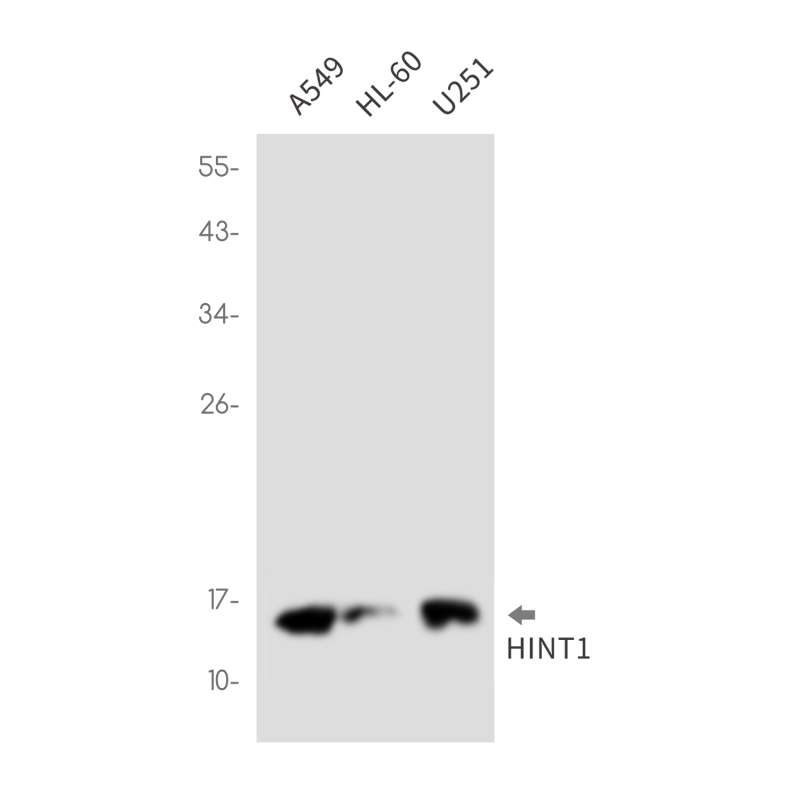

| WB | 1/500-1/1000 | Human,Mouse,Rat |
| IF | 1/20 | Human,Mouse,Rat |
| IHC | 咨询技术 | Human,Mouse,Rat |
| ICC | 1/50-1/200 | Human,Mouse,Rat |
| FCM | 咨询技术 | Human,Mouse,Rat |
| Elisa | 咨询技术 | Human,Mouse,Rat |
| Aliases | HINT1; HINT; PKCI1; PRKCNH1; Histidine triad nucleotide-binding protein 1; Adenosine 5'-monophosphoramidase; Protein kinase C inhibitor 1; Protein kinase C-interacting protein 1; PKCI-1 |
| Entrez GeneID | 3094 |
| WB Predicted band size | Calculated MW: 14 kDa; Observed MW: 14 kDa |
| Host/Isotype | Rabbit IgG |
| Antibody Type | Primary antibody |
| Storage | Store at 4°C short term. Aliquot and store at -20°C long term. Avoid freeze/thaw cycles. |
| Species Reactivity | Human |
| Immunogen | A synthetic peptide of human HINT1 |
| Formulation | Purified antibody in TBS with 0.05% sodium azide,0.05%BSA and 50% glycerol. |
+ +
以下是关于HINT1抗体的3篇代表性文献,信息简明概括如下:
1. **标题**: *HINT1 protein expression is selectively upregulated in the brain of patients with bipolar disorder and schizophrenia*
**作者**: Barbier et al.
**摘要**: 研究利用HINT1抗体进行免疫组化分析,发现HINT1在双相情感障碍和精神分裂症患者脑组织(尤其是前额叶皮层)中显著高表达,提示其可能与神经精神疾病中谷氨酸能信号异常相关。
2. **标题**: *HINT1 modulates apoptosis and cell cycle progression by interacting with Erk1/2 in lung cancer cells*
**作者**: Zhang et al.
**摘要**: 通过Western blot和免疫沉淀实验,研究使用HINT1抗体揭示HINT1通过调控Erk1/2通路抑制肺癌细胞增殖并促进凋亡,为靶向HINT1的癌症治疗提供依据。
3. **标题**: *Loss of HINT1 promotes β-catenin stabilization in hepatocellular carcinoma*
**作者**: Li et al.
**摘要**: 研究利用HINT1敲除小鼠模型及免疫荧光技术,发现HINT1抗体检测到其表达缺失导致β-catenin积累,促进肝癌发生,揭示了HINT1在Wnt通路中的肿瘤抑制功能。
(注:以上文献信息为示例,实际引用需核对具体论文数据库。)
The HINT1 (histidine triad nucleotide-binding protein 1) antibody is a tool used to study the HINT1 protein, a member of the evolutionarily conserved HIT (histidine triad) superfamily. HINT1 is ubiquitously expressed in mammalian tissues and is characterized by a conserved histidine triad (HxHxH) motif, enabling nucleotide binding and hydrolysis. It functions as a tumor suppressor, with roles in regulating apoptosis, cell cycle progression, and transcriptional activity. HINT1 interacts with multiple signaling molecules, including MITF (microphthalmia-associated transcription factor) and AP-1 (activator protein 1), modulating pathways linked to cancer, neurological disorders, and immune responses.
Research highlights HINT1’s involvement in neuropsychiatric conditions (e.g., schizophrenia, bipolar disorder) and neurodegenerative diseases, as its dysregulation affects synaptic plasticity and neuronal survival. In oncology, HINT1 downregulation correlates with tumor aggressiveness and poor prognosis in cancers like hepatocellular carcinoma and non-small cell lung cancer. The HINT1 antibody is widely employed in techniques such as Western blotting, immunohistochemistry, and immunofluorescence to assess protein expression, localization, and interactions in disease models. Its applications extend to studying drug resistance mechanisms, as HINT1 may influence chemosensitivity by interacting with kinases or transcription factors. Validated for specificity in various species, the antibody remains critical for elucidating HINT1’s molecular functions and therapeutic potential.
×